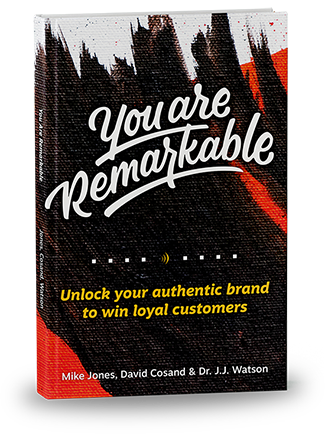Podcast: Play in new window | Download
Subscribe: RSS
Note: Here's the worksheet we use. Download our brand story worksheet for free..
Everyone wants to feel good about the story they tell about themselves — one that will give you a script and make you feel great about what you do and one that you'll be proud to share (instead of nervous). Whether it's an elevator pitch, a job description, text for a proposal, a slideshow, a conversation or the footer of your website here's how to build a brand story that will make sense for you and your brand.
What’s a Brand Story?
Great brand stories do actual work. They give your hearer focus. If you can do that, you can take them down a path. And if your path makes sense, you might even use that valuable attention you got (read: earned) from them to offer your solution.
A brand story, like any story, needs tension. So usually there's some kind of problem that exists for your customer or client. The story needs characters and those characters have to make sense to the hearer. And it needs a solution that involves you.
Characters in a Brand Story
Before we get to the steps, let's make sure we understand the characters. As I mentioned, if the reader doesn’t care about the characters, the plot is irrelevant. To illustrate, have you ever watched a TV show or romantic comedy with a couple that you just know should be together? Maybe they’re alone or with someone who mistreats them, and now they have a chance at love. She’s funny and innocent. He’s clever and heroic. They need each other. "No, you don’t understand: they NEED to be together!"
So you keep watching as chemistry builds. Then the inevitable happens and something goes wrong. A previous lie emerges. Someone gets in the way. A misunderstanding threatens all their future happiness.
And you care.
It’s a fictional couple. Actors. And you know it. But you care anyway. In fact, if you paid for that movie, you actually paid to care about fake people!
That’s tension and it involves you in the story. It’s what you want.
But if you don’t care about the characters — maybe she’s just kinda immature and he’s still a good guy — you’re likely to think he deserves better. Or they’re just uninteresting or unlikeable. In that case, you just don’t really care if they’re together.
So make sure they care about the characters. For a deeper dive, check out this article on why we care about characters.
The Hero’s Journey
Who are the characters in your brand story, you might ask? In a RomCom, they’re a would-be couple. But in a brand story, it’s a different kind of story. It’s about a hero, the hero’s journey and you (the guide).
In this story, your hero is your customer and you are the guide, whether you're selling a product or service that helps them build or do something.
Now that your characters are set, let’s talk about the story arc.
Steps to a Brand Story Plot
Now that you have characters, you need tension, which usually takes the form of an obstacle between where your hero is and where he or she needs to be.
1) Beginning — State the Problem
You have to state the problem, capturing their problem in a way that makes sense to them. You want them to understand that you see the problem, putting you on the same side of the table as them.
If you can do this, you’ve conquered much of the sales process. So state the problem the way they would care about it.
Bonus: make it brutally true and clear. This is sometimes called “agitation.” It works by making sure your client continually sees the value. Usually, it describes the suckiness of their situation.
Remind them why the problem is important. Don’t sanitize it. Let it be severe.
Think about a time when you've watched a movie where the hero gets the living hell beat out of him by the bad guy. He just gets destroyed. And just when you think it’s over, it gets worse. Pretty soon, you’re at the point where you’re wondering how he’s even gonna survive. But the closer he comes to death — the more it looks like he could never come back from this — the more you’re into it. And yet, you know it’s possible because it’s that kind of movie.
And now you just have to see how he comes back.
So now you have a character you care about, and you’ve given the story tension and a goal (the implied goal of the comeback).
Great storytellers don’t let up. They have no mercy. Because the farther you fall, the better the comeback.
2) Middle — Your Arrival in the Brand Story
So your hero’s beaten to a pulp. Now what? How does your arrival change the hero's perspective? How do you change how the hero sees things?
Remember, it’s important that you don’t solve the problem here. You only provide the inspiration — the hint at the actual solution.
As the guide, you don’t change the hero situation (yet), you simply change his point of view. Think of Yoda and Luke, Gandalf and Frodo. Think about any time in the story where a hero was given counsel and hope.
And the guide is invested. Yoda knows Luke has to go out and do it, but he wants Luke to win. He doesn’t just give him a slideshow presentation on the force, wish him good luck and go back to eating swamp food.
No, a great guide — and a great brand — give the hero a feeling of hope and a feeling of your support. You’re behind them, and you matter, so “maybe I can be successful.”
Gandalf was kind of awesome. Yoda was kind of awesome. Obi-Wan was kind of awesome. There are so many guides who’ve gone before us. They've paid their dues. They bring a confidence that gives confidence to this young, developing hero.
And so the hero's perspective shifts when you show up and create that confidence.
3) End — Your Hero’s Victory
So we've talked about your arrival and how you've changed the hero's perspective, so now let's talk about how your hero came out victorious.
For inspiration, think of ways you or your product helps real people. How have you seen this play out in the past? Remember that they’re the ones who overcome. But how did you contribute to their ability to overcome? How did you instill confidence and a small amount of ability?
You have a small role, but you do have a role.
4) Bad Ending — What if They Refuse Your Help?
Now we define the bad ending. Why? Because it gives you more backstory to draw from, even if you never mention it to people.
This is what happens when the hero doesn't overcome.
You wrote the good ending a minute ago. The one where they take your help. But what if they don't? What if they don't get your change of mindset which you would otherwise have instilled in them, if they didn't use the product or service, then what happens?
And you can’t just say “they stay the same.” Things get worse if they’re not getting better. So be real with them. Tell them the worst that can happen.
Sure, they ultimately go out of business. But you want to enrich the story and say why they went out of business or how they failed. What was the path? This alternate ending should create tension in your heart and motivate you to help.
5) Edit Your Brand Story
Finally, you have all the facts aligned. The information is all there. Now, it's a matter of putting it together, compressing some parts, expanding others, and making it your own. But just remember that a brand story is about how you help your client or customer win; it's a story that's about them. And that's why it's compelling. It's a story where your customer is the main character with the problem, and you are the one helping them out of the problem. You create the tension, and you let your story do the work.
This is how you create consistency in the communication of your brand throughout your organization.
Download the worksheet and get yourself and your team on the same script.



